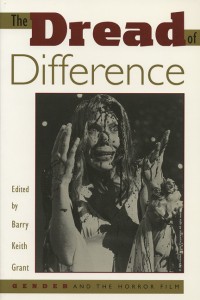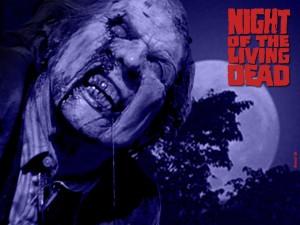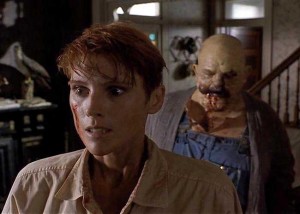 If we probe horror in cinema more deeply we find it touches on a number of aspects of the human experience. One of these is related to gender. An excellent book that looks at various facets of this topic is The Dread of Difference: Gender and the Horror Film (University of Texas Press, 1996). (The book’s Table of Contents and Introduction can be previewed here.) The book is edited by Barry Keith Grant, Professor of Film Studies and Popular Culture at Brock University in Ontario, Canada. Grant discusses his chapter in the book, “Taking Back the Night of the Living Dead: George Romero, Feminism, and the Horror Film” in the following interview.
If we probe horror in cinema more deeply we find it touches on a number of aspects of the human experience. One of these is related to gender. An excellent book that looks at various facets of this topic is The Dread of Difference: Gender and the Horror Film (University of Texas Press, 1996). (The book’s Table of Contents and Introduction can be previewed here.) The book is edited by Barry Keith Grant, Professor of Film Studies and Popular Culture at Brock University in Ontario, Canada. Grant discusses his chapter in the book, “Taking Back the Night of the Living Dead: George Romero, Feminism, and the Horror Film” in the following interview.
TheoFantastique: Barry, thank you for making time in connection with your New Year’s celebration to discuss your book. In The Dread of Difference, you note in the introduction that traditionally science fiction and horror films have focused on the question of difference, the other, usually understood in terms fears such as of communism or late capitalism. You suggest, and the contributors to the volume demonstrate through their chapters, that “issues of gender remain central to the genre.” How has feminist theory impacted film interpretation as a means of providing another interpretive layer to our understanding of horror and science fiction?
Barry Keith Grant: I think the explanation is simply a matter of criticism catching up with social change. Sociological, mythic, and vaguely psychoanalytic theory and concepts informed earlier analyses of horror films. These ideas were informed by unquestioned assumptions about “man” and consequently, gender wasn’t regarded as an important issue. It took certain developments in feminist theory and feminist film theory to get people thinking differently and to inspire a new interest in popular film generally and in horror specifically. Not coincidentally, these developments in academic theory were happening roughly simultaneously with the feminist new wave in science fiction.
In my view, it is impossible to underestimate the impact of feminist theory and feminist film theory for our understanding of cinema generally and for horror and science fiction especially. Laura Mulvey’s 1975 discussion of “Visual Pleasure and Narrative Cinema,” in which she posited the idea of a gendered gaze and the patriarchal “look” of the camera in mainstream film, and Robin Wood’s late 1970s writings on ideology in the horror film, informed by Marxist and feminist theory, set the stage for much of the understanding and analysis of both science fiction and horror in the decades to follow.
Such criticism has given us an awareness of “the dread of difference” that seems to haunt horror and offers utopian alternatives in science fiction. In a way, the criticism about these genres by scholars such as Christopher Sharrett, Vivian Sobchack, Harry Benshoff, and Carol Clover is like the science fiction of, say, James Tiptree, Jr., Marge Piercy, or Joanna Russ — it makes us all more conscious of the way our assumptions about gender inform our relations with other people and with the world.
 TheoFantastique: You suggest in your contribution to the book that George Romero, through the 1990 remake of Night of the Living Dead, has sought in some senses to overcome “his own monstrous offspring.” Can you touch briefly on what you mean by this?
TheoFantastique: You suggest in your contribution to the book that George Romero, through the 1990 remake of Night of the Living Dead, has sought in some senses to overcome “his own monstrous offspring.” Can you touch briefly on what you mean by this?
Barry Keith Grant: I was referring to the less distinguished but nonetheless prevalent — even dominant — presence of horror and science fiction movies that are formulaic recyclings of ideas that were fresh and innovative, even political, in earlier films. Such fare is characteristic of all popular culture genres that are as popular as horror and science fiction, and are probably further evidence of “Sturgeon’s Law.” Cheap knock-offs can be found in art and entertainment just as in brand name fashion wear and electronics. In the case of movies, “cheap” doesn’t apply simply to budget, but also to imagination. So, in other words, I was arguing that in reconceptualizing Night of the Living Dead the way he did for the remake, Romero was trying to redress way too many horror films had reduced his social messages to mindless misogynist violence.
TheoFantastique: Romero’s zombie myth has been interpreted as offering a critique of consumerism and racism. You address issues of gender and sexual politics. Why do you think this aspect of Romero’s zombie myth has not been given the same treatment as other aspects of his storytelling?
Barry Keith Grant: The essay was first published in 1992 in a special genre issue of Wide Angle, once an important academic journal in film studies. Of course, I had written it a year, perhaps two, earlier, as the essay then had to go through the standard and time-consuming peer review process of academic journals, then accepted and placed in the queue before it actually appeared in print. At this time, there were few critics taking George Romero seriously — Robin Wood, Christopher Sharrett, Tony Williams, a few others. The reason for this, clearly, was the lowbrow status with which horror was regarded, for anyone who cared to look seriously at Romero’s films would see an intelligence, an auteur, working within the genre with some serious ideas. It was a puzzle to me why more film scholars weren’t paying more attention to Romero, and to the genre more generally.
Today, almost twenty years later, the situation is rather different, and I don’t think I would make this claim. Indeed, critical commentary on horror, both in traditional print form in journals and books, and in newer digital forms of websites and blogs, such as your own, issues of gender are now common topics in discussions of horror and science fiction, as they are in discussions of other popular genres such as action movies.
TheoFantastique: In your chapter you make an interesting connection between the work of Howard Hawks and its influence on Romero. How do you see this as playing out in 1990’s Night?
Barry Keith Grant: Well, I think to summarize this argument is essentially to summarize the essay, and of course I would prefer that your readers read the essay itself. But in a nutshell, as I tried to argue in the essay is that Romero conceives of the threat of the undead in his zombie films as a situation that calls for violent and unsentimental resistance in order to survive. This is analogous to the frequent situation in Hawks’s action films wherein a mostly male group must employ their own code of professionalism, dictated by the situation rather than some institutional system, to get their job done and reach their goal. (Unlike Hawks, though, Romero’s films follow through on the revolutionary potential of this idea.)
 The remake’s major change is in the reconceptualizing of Barbara. Rather than a completely helpless women who must be cared for throughout the siege of the farmhouse by the zombies, as in the original film, the makeover Barbara of the second version transforms from an archetypally meek female into a self-sufficient fighter able to meet the threat of the attacking undead. In order to meet this challenge, and to survive, Barbara must learn to do what is necessary, without sentimentality. The film carefully contextualizes the zombie threat as a metaphor for the horrors of masculine violence and aggression, and her deliberate shooting of Harry this time around makes this point clear.
The remake’s major change is in the reconceptualizing of Barbara. Rather than a completely helpless women who must be cared for throughout the siege of the farmhouse by the zombies, as in the original film, the makeover Barbara of the second version transforms from an archetypally meek female into a self-sufficient fighter able to meet the threat of the attacking undead. In order to meet this challenge, and to survive, Barbara must learn to do what is necessary, without sentimentality. The film carefully contextualizes the zombie threat as a metaphor for the horrors of masculine violence and aggression, and her deliberate shooting of Harry this time around makes this point clear.
TheoFantastique: You reference R. H. W. Dillard who has stated that the original Night articulated “a fundamental nihilism and negation of human dignity.” To what extent do you see Romero’s successive zombie films overcoming this, if at all, and if not, how strong an influence might the original Night continue to be on the nihilism of contemporary postmodern horror?
Barry Keith Grant: Romero’s vision is a rather pessimistic view of contemporary society, particularly as it is informed by the values of patriarchy and capitalism. The follies of homo Americanus are amply demonstrated in Land of the Dead, where the political critique becomes most explicit. In the end, there is nothing for the protagonists to do but light out for the territory of Canada, like Romero himself.
Survival of the Dead offers some clever new ways to kill zombies, including sticking the hose of a fire extinguisher in their mouths and filling their heads with fire retardant until it oozes from their various facial orifices and their eyes pop out as in a Frank Tashlin cartoon. But such creative carnage is minimized in favor of excessively broad political satire about two warring clans on an island off the U.S. east coast. Focusing on a Hatfield-McCoy type feud between the two groups, Romero pours southern Gothic and western movie iconography into Delaware, which the last time I looked was a middle Atlantic state. Well, why not? We already have Pride, Prejudice and Zombies.
This composite portrait may be seen as an attempt to subvert the America represented in the westerns of John Ford, which Romero has said he wanted to acknowledge as an influence. Alternatively, perhaps Romero has been based outside of the U.S. so long (the film was shot in rural Ontario) that he may have lost all sense of the country’s geography. Ultimately, the satire is even thicker than the blood this time around, and it suggests that Romero’s view is no less bleak than before.
As for the influence of Romero’s zombie films on contemporary nihilism, I think while tit has certainly inspired and influenced so many others, and the direction of the genre generally in the 1980s toward splatter, at the same time it also expresses through a resonant horror mythology a nihilism that we have every good reason to be feeling in any case as we continue to ravage the planet and make war on each other. Olaf Stapeldon’s Last and First Men should be required reading of anyone holding political power!
TheoFantastique: Barry, thank you again for making some time to discuss your chapter. I hope this discussion gives readers new reasons to pick up a copy of the book.





Hi,
Great site. Im in the process of compiling mine, any advice? Ive been at it
for weeks and just can’t seem to make it look as cool as others, like yours..
Regards
Richard